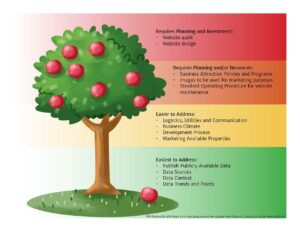There have been a number of articles and books published which address a company’s need to identify its competitive advantage. It’s not only important for companies, but it is also important for communities to develop and promote competitive advantages, as marketing plans are developed and businesses are courted. One definition of a sustained competitive advantage: “when a firm is implementing a value-creating strategy not simultaneously being implemented by any current or potential competitors and when these firms are unable to duplicate the benefits of this strategy”.
Similar to a competitive advantage is competitive positioning. You may not have a competitive advantage at all, but if you make a claim first, and loudest, your competitors have all they can do just to keep up. Although these concepts have been applied in the private sector, the ideas can also be easily transferred to the public sector. Your competitors are all the other communities hoping to lure the same new businesses away from your business park or downtown and to their doorstep.
A good place to start is with an analysis of your Strengths, Weaknesses, Opportunities and Threats (SWOT). A SWOT analysis won’t point out your competitive advantages however. It may help you narrow your focus on a few ideas, but to really drill down into the competitive advantages that will sell your community to any prospective businesses you’d like to locate in your city, you need to translate those strengths and opportunities into something meaningful to the prospect. To have a competitive advantage relative to other areas in attracting and serving a target industry, a community must have more of the attributes needed or preferred by the target industry than any other community.
Keep in mind if you are touting a competitive advantage that you believe is important but it’s really not that important to a prospect, it will mean nothing to them. Also, you will want to present your advantages on the basis of your region, the state, and the nation if applicable, as your prospect may be comparing sites on any of those levels. Resources, infrastructure, research connections, available workforce housing, complex clusters of related supply/product chains, available skilled workforce, networks of industry experts all could be positioned as competitive advantages for a community. The list could be endless but is only valuable if it is what the prospect wants.
Once the competitive advantages or positions have been identified, a focused marketing plan must be developed to communicate the advantages. You have to communicate them to all the stakeholders in the community who may come in contact with prospects and all of your existing or potential prospects. Where and how these should be marketed will be addressed in a future post. Stay tuned!






